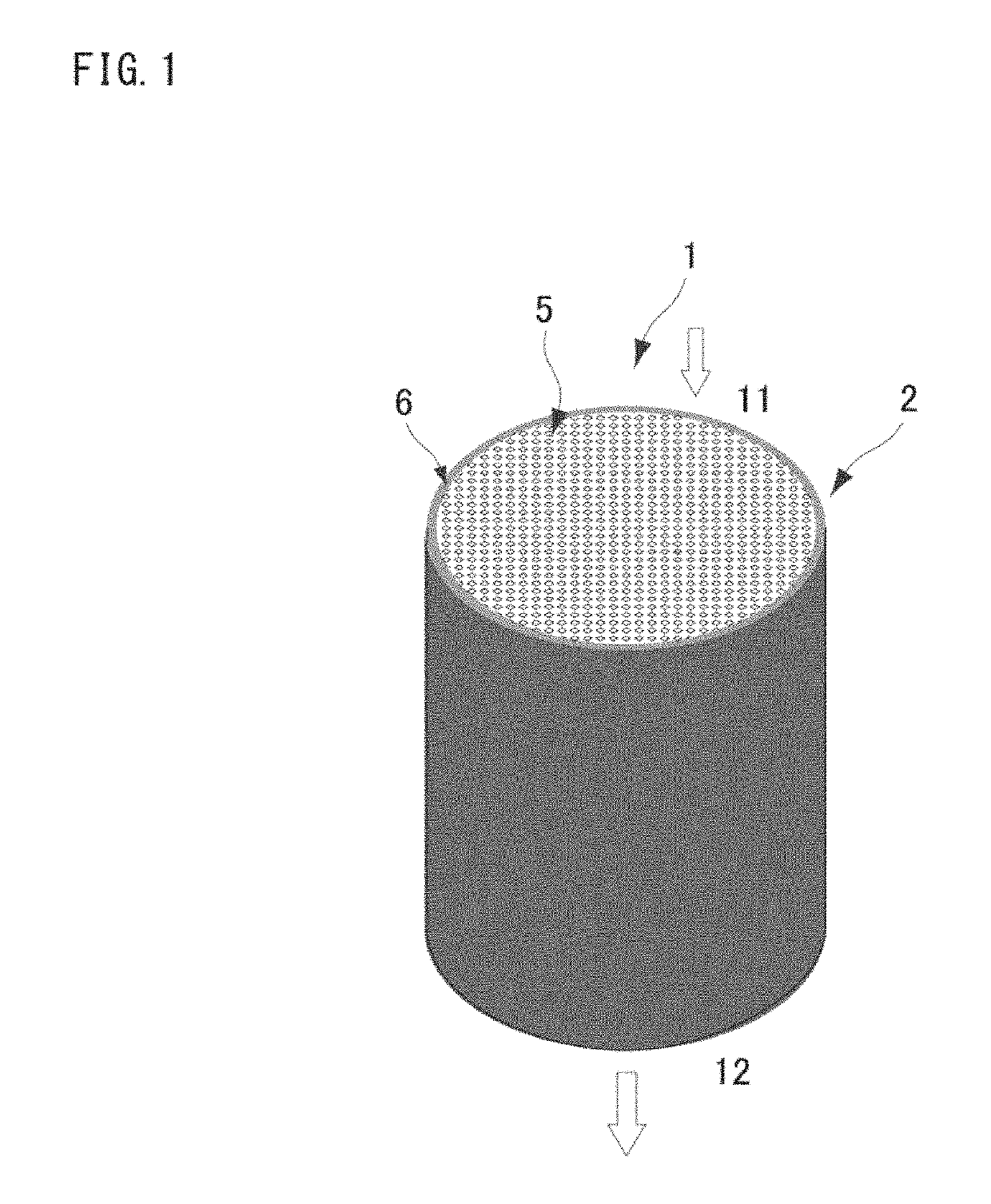Honeycomb structure, honeycomb structure type catalyst and production methods therefor
- Summary
- Abstract
- Description
- Claims
- Application Information
AI Technical Summary
Benefits of technology
Problems solved by technology
Method used
Image
Examples
working examples
[0179]Hereinafter, the present invention will be described in more detail on the basis of working examples, but the invention is not limited to these examples.
(Honeycomb Substrate)
[0180]As a base material of the honeycomb structure, a cordierite made wall-flow honeycomb manufactured by NGK Insulators, Ltd., was prepared. Details are as follows.[0181]Porosity: 65% for both the outer wall and the partition walls[0182]Average pore diameter: Volume average of 20 μm measured by mercury porosimetry method[0183]Partition thickness: 10 mil (approximately 0.3 mm)[0184]Cell density: 300 cel / inch2 (approximately 46.5 cel / cm2)[0185]Diameter: 4.66 inch (118.4 mm)[0186]Length: 5 inch (127 mm)
(Evaluation)
[0187]The honeycomb structure was wash-coated with a catalyst slurry. In the air blowing step, it was evaluated as “leaching occurred (Bad)” when the slurry leached out to the outer peripheral, and it was evaluated as “leaching not occurred (Good)” when the slurry did not leach out.
[0188]Then, the...
working example 1
(1. Impregnation of Resin Composition to Honeycomb Substrate)
[0191]First, a polyvinyl alcohol (PVA) having an average polymerization degree of 1,900 was dissolved in water to prepare a resin composition solution of 5% by mass as a resin coated part formation liquid. The viscosity of the resin composition solution (measured at 25° C. with a Brookfield type viscometer) was 6 mPa·s.
[0192]Next, the resin composition solution was placed in a liquid bath of a coating apparatus, and the honeycomb substrate was placed on two coating / driving rollers so that the circumferential side faces of the rollers and the honeycomb substrate were in contact with each other. Then, the undersides of the coating / driving rollers were brought into contact with the resin composition solution. Thereafter, while the coating / driving rollers were rotated at a rotation speed of 60 rpm and the resin composition solution was constantly supplied, the resin composition solution was applied to the surface of the honeyc...
working example 2
[0200]A honeycomb structure having a resin coated part of the resin composition was prepared in the same manner as in Working Example 1 except that an acrylic resin (an aqueous varnish, manufactured by Washin Paint Co., Ltd.) was used in place of the polyvinyl alcohol used in Working Example 1.
[0201]When visually inspected from both end faces of the honeycomb, as with Working Example 1, it was confirmed that the resin composition solution was all impregnated into the outer peripheral wall. The resin composition solution (acrylic resin) was applied in an amount of approximately 8 g / L over the entire outer surface of the outer peripheral wall of the honeycomb substrate.
[0202]Once the honeycomb structure was dried, the acrylic resin, which was a resin composition, was all impregnated into the outer peripheral wall, and no layer of acrylic resin alone was formed on the outer peripheral wall surface. The honeycomb structure having such a resin coated part would suppress slurry from leach...
PUM
| Property | Measurement | Unit |
|---|---|---|
| Fraction | aaaaa | aaaaa |
| Pore size | aaaaa | aaaaa |
| Density | aaaaa | aaaaa |
Abstract
Description
Claims
Application Information
 Login to View More
Login to View More - R&D
- Intellectual Property
- Life Sciences
- Materials
- Tech Scout
- Unparalleled Data Quality
- Higher Quality Content
- 60% Fewer Hallucinations
Browse by: Latest US Patents, China's latest patents, Technical Efficacy Thesaurus, Application Domain, Technology Topic, Popular Technical Reports.
© 2025 PatSnap. All rights reserved.Legal|Privacy policy|Modern Slavery Act Transparency Statement|Sitemap|About US| Contact US: help@patsnap.com



